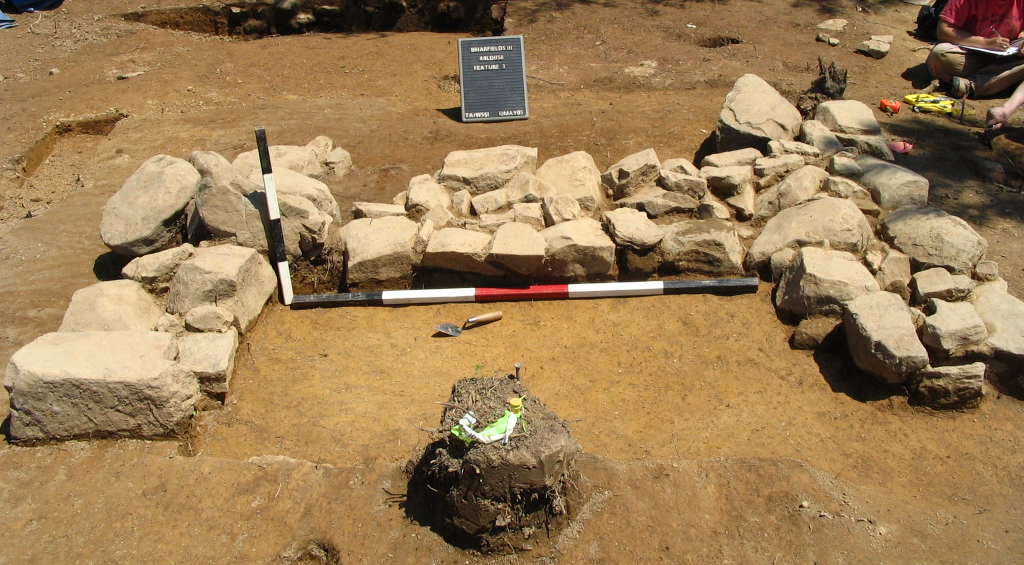Briarfields Property - Site 44LD1158
Loudoun County, Virginia
Owner: Richmond American Homes
WSSI's Thunderbird Archeology division discovered Site 44LD1158, located approximately one-half mile west of Arcola on the south side of Briarfield Lane in Loudoun County, Virginia, during of a Phase I study of the Briarfield Estates property in 2004. WSSI’s subsequent Phase II evaluation confirmed the site's eligibility for listing on the National Register of Historic Places. WSSI completed the Phase III data recovery work in compliance with the U.S. Army Corps of Engineers wetland permitting process.
The Phase III data recovery involved systematic close interval shovel testing, the mechanical stripping of the soils at the site to expose sub-surface features, the bisection of discovered features, and the excavation of four 3 by 3 foot test units. The Phase III investigations resulted in the recovery of an assemblage of artifacts associated with a domestic site most likely occupied from circa 1770 through circa 1830. While dominated by kitchen-related artifacts, the assemblage includes a variety of decorated ceramics that suggest the occupants of the site had a modicum of wealth with which to purchase consumer goods beyond the bare necessities. Historic records indicate that, at the time the site was occupied, portions of the tract on which the site is situated were leased to at least three tenants, one of whom was the likely occupant of site 44LD1158.
The investigations also revealed a stone hearth foundation and house pit that mark the location of the main dwelling, as well as a series of pit features in the western portion of the site that apparently resulted from a variety of activities including food preparation, bone button manufacture, butchering, and refuse disposal. Some of the artifacts, and the historic records, suggest that this tenant household may have included one or more slaves.
Bone button material
The household at 44LD1158 likely farmed the land surrounding the dwelling and engaged in a variety of activities in the yard areas adjacent to the house. Some evidence of bone button manufacture was observed; however, this was not on a scale large enough for commercial purposes and was more likely for the use of the site’s occupants. Clear evidence was found of the butchering of cows and pigs for consumption in the dwelling. A single colonoware sherd was found, as well as 16 rounded ceramic sherds, which are interpreted by some as gaming stones. With the exception of one sherd, these were found in the area which also contained the evidence of bone button manufacture. Whether or not this indicates a slave presence is unclear. At the least, the presence of the colonoware sherd represents the site’s presence in a society in which slavery was a part of everyday existence. Of the tenants named in a 1792 deed, Thomas Pritchard and William Beaty both owned slaves and could well have been the occupants of site 44LD1158.
Excavated hearth feature
Hearth Feature
We do not (and may never) know precisely who lived at 44LD1158. It is likely that the site was occupied by a tenant household of moderate means who farmed land leased from the landowner. We do know that the household was not entirely impoverished and was able to spend a modest amount of money on more costly material possessions such as decorated ceramics and glass windowpanes. The house and its surrounding yard were the site of a variety of activities concerned with the sustenance and provisioning of the household, which may have included one or more enslaved African Americans. While there was some spatial separation of the actual living space from the generalized activity area, there was no clear evidence that the various activities were spatially separated. There was also no evidence that the freed and enslaved members of the household occupied and used different areas of the site. This tenant household had fewer of the clear divisions between activities and between people of different status than what was the norm in a plantation community. Here, people likely shared work, space, and probably material goods, leaving a blurred and overlapping archeological record of this tenant household’s daily life.




